Events and excursions, Summer 2024
The Byron Lecture
27th June 2024 at the Djanogly Theatre, Lakeside Arts, University Park
"Mad, bad, and dangerous to know" was a phrase used by Lady Caroline Lamb to describe her lover Lord Byron.
George Gordon Byron, 6th Baron Byron (22nd January 1788 — 19th April 1824), certainly had a reputation to live up to. 200 years after his death he is remembered, commemorated, and celebrated for being the poet and the man who he was, not just in this country but around the world. Nottinghamshire should be proud of the heritage he left us the Jewel in the crown’ being Newstead Abbey in the heart of Sherwood Forest. Nottingham City Council has owned and maintained the Abbey since it was given to the Corporation in 1931 by the local philanthropist, Sir Julien Cahn.
To mark the bi-centenary of Byron’s death a special lecture was organised by the University of Nottingham, with six guest speakers and chaired by Associate Professor Richard Gaunt from the Department of History.
The guest speakers were:
Councillor Pavlos Kotsonis, Executive Member for Adult Social Care and Health.
Dr Sam Hirst, Post-Doctoral Knowledge Exchange Fellow at the University of Nottingham.
Simon Brown, Curator at Newstead Abbey, the ancestral home of Lord Byron. Madeline Potter, Early Career Teaching and Research Fellow in the Long Nineteenth Century (Romanticism/Victorianism), The University of Edinburgh.
John Beckett, Emeritus Professor of English Regional History, University of Nottingham.
Miranda Seymour, novelist, biographer, critic, and visiting professor at Nottingham Trent University.
Geoffrey C. Bond, OBE, author, broadcaster, producer, historian, and present owner of Burgage Manor, once occupied by Lord Byron.
The lecture was divided into two parts:
Part 1

The speakers at the Byron Lecture before the interval: Dr Madeline Potter, Dr Sam Hirst, Cllr Pavios Kotsonis, Simon Brown, Dr Richard Gaunt (photo: The University of Nottingham).
Councillor Kotsonis outlined the Council’s role in maintaining Newstead Abbey and the links we have with Greece and the area where Byron died.
Simon Brown, as curator of Newstead Abbey, gave us an insight into how Newstead Abbey is marking the bi-centenary, by highlighting the collections held at Newstead linked to Byron and providing a special insight into the Byron legacy for visitors to see during 2024.
Dr Sam Hirst and Dr Madeline Potter outlined how their academic research is bringing Byron to a new generation in schools and universities, teaching them about Byron and his contemporaries.
During the interval, I asked Simon Brown, “Given the current financial situation that Nottingham City Council is in, is Newstead Abbey and the collection safe?”. Thankfully he confirmed that they are.
Part 2 (after the interval)
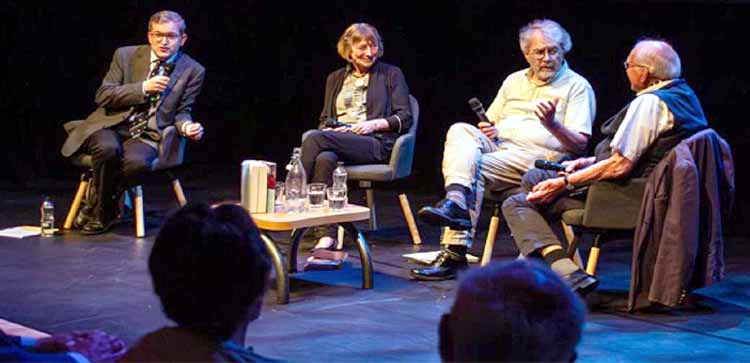
The speakers at the Byron Lecture before the interval: Dr Richard Gaunt, Miranda Seymour, Professor John Beckett, Geoffrey Bond OBE (photo: The University of Nottingham).
The second part of the lecture was more informal with a panel of speakers, Geoffrey Bond, Professor John Beckett, and Miranda Seymour hosted by Dr Richard Gaunt.
Starting the proceedings, Geoffrey Bond gave an amusing and excellent resume on the life of Lord Byron and, for anyone there who did not know much about Byron, Geoffrey enlightened us all.
Geoffrey Bond also spoke about the Byron family who once lived in Burgage Manor in Southwell, which he owns and occupies with his family.
We were then entertained by Professor John Beckett, who drew upon his vast academic knowledge, highlighting both Byron’s connections with Newstead Abbey and the family’s property in Rochdale.
Finally, Miranda Seymour, whose ancestral home is Thrumpton Hall in Nottinghamshire, gave us an insight into her family connections with Byron and its connection with Ada Lovelace, Byron’s daughter, who stayed there on her visits to the county.
As the evening drew to a close, thanks were extended to all of the speakers who had given us an enjoyable evening, enhancing our knowledge of George Gordon Byron and his role and importance in Nottinghamshire’s literary heritage.
Kevin Powell
A VISIT TO TRENT BRIDGE
17th JUNE 2024
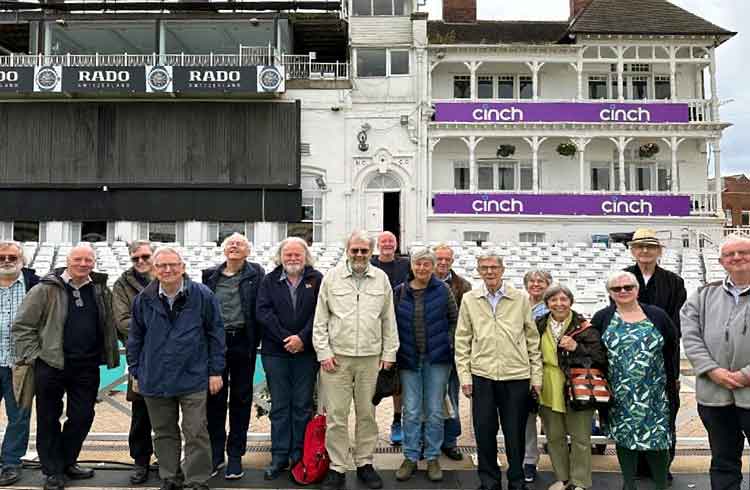
An intrepid group of Thorotonians led by our President and Chair of Council visited Trent Bridge Cricket Ground for a prearranged trip organised by Paul Baker, who is a member of the Nottingham Cricket Club. Following a very valuable historical talk about Trent Bridge in the Wynne Thomas Library by Steve le Motte, the Heritage Officer at Trent Bridge it was time to explore with our guide. Trent Bridge, is, of course, a world-famous cricketing landmark, where many Test Matches have been played.
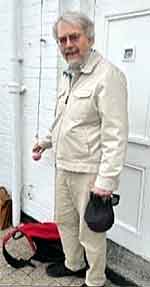 John becket ringing the 5-minute bell
John becket ringing the 5-minute bellOur visit coincided with a day off for cricketers and we had more or less the run of the ground, we even got to walk on the hallowed turf. We saw the players’ dressing rooms, and the Committee Room in the Pavilion as well as being introduced to the library and archives. We then walked to the far end of the ground to see the great new stand from which we could look down from a great height on the wickets. Finally, we saw the places from which the broadcasters send their thoughts to the cricket-listening world. This was a excellent way to spend a Monday morning and your President got to ring the 5-minute bell on the Pavilion.
The bell signals that the umpires need to take up their positions ‘in the middle’, followed by the fielding side and the batsmen. Alas with no cricket the only people who got to hear it were the rest of our party!
John Beckett
A few interesting Trent Bridge Historical Dates
| 1771 | First newspaper mention of cricket in Nottingham (cricket would have started before 1771) |
| 1813 | First Nottingham Town v. County cricket match |
| 1840 | First Inter County match v. Sussex at Trent Bridge |
| 1898-99 | Ground enclosed by seating |
| 1899 | First Test Match at Trent Bridge: England v. Australia (match was drawn — W G Graces’ last Test) |
| 1915 | Trent Bridge Pavilion took its first patients as a Hospital. By the end of the First World War, 3,500 servicemen had been treated at Trent Bridge |
| 1925/26 | New stands were built at Radcliffe Road end and Hound and Fox Roads |
THE 1620s HOUSE AND GARDEN AT DONNINGTON HEATH 12th JUNE 2024
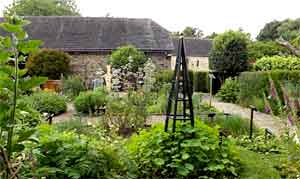 Part of the impressive gardens (photograph Ruth Strong)
Part of the impressive gardens (photograph Ruth Strong)The 1620s House and Gardens is one of Leicestershire’s oldest houses, originally built around 1290. The Digby family were the owners from the 15th century. This interesting day for the Thoroton Society members allowed us to have an excellent tour of the house and be expertly led around the garden learning a great deal about the plants and the variety being grown. The restored 17th-century gardens included the rose garden, the dye plant beds, the working plant garden, the formal herb garden, and the maze. The expert garden guide was able to enlighten us about using the plants, both for medicinal use and as food. The tour of the House was a real step back in time too and a history lesson on how people lived 400 years ago. We started in the Scullery, which with its easy access to the garden and the well in the yard outside would have the fruit, vegetables, meat, and fish would have been washed. Our guide explained about the preservation of the food here and also how the Scullery would have been used as the washing up area and the laundry. From the Scullery, we moved into the Buttery and the Pantry where the food storage would have been managed. Here food would be stored with a careful eye being kept for pests such as mice and rats. The guide explained how the House’s water supply and Well yard functioned and where food was finally prepared in the Kitchen and Parlour. This was an interesting introduction to how the family and servants would eat together most days. It was explained that when the family were entertaining guests the food would be prepared here and then taken to the Great Chamber by the external staircase to the Lobby.
The tour continued onto the first floor of the House with us able to visit the Study, which originally would have been the most private room in the house, being reached through one of the bedrooms. This was where Mr. Digby would manage his business interests. It is thought that this room may well have been originally a chapel as our guide pointed out the trefoil (a Christian representation of the Father, Son, and Holy Ghost). In the 1620s the Digbys retained the Catholic faith despite the Catholic Mass being illegal. The secret function of this room was explained to us because the family and visitors would have been executed if caught practicing the Catholic faith. We next visited the Corridor bedroom, the Great Chamber, and the Private Bedroom. The excursion to this restored 17th-century house was an excellent historical experience, enjoyed by all who attended.
Paul Baker
BEAUVALE PRIORY, ST MARY’S GREASLEY AND D. H. LAWRENCE BIRTHPLACE MUSEUM
18th JULY 2024
It was a much-reduced group that made its way to Beauvale Priory. With only seven members, we were able to car share and travel under our own steam. Thursday, 18th July was a beautiful day, the best weather of the month so far. Beauvale Priory is not usually open on Thursdays so we had the site to ourselves. We were greeted by Ann, the owner, who proceeded to give us a very extensive and interesting tour of the site, explaining the history of the Priory. Beauvale had been built by the De Cantilupe family in 1343 for the Carthusian Order of monks. The Carthusians were (and are) a silent order who lived separate lives in individual cells. They remain apart from the outside world.
The ruins retain the characteristics of the original Priory, even though its use was adapted for other purposes, especially after the Dissolution. The Prior’s house retains traces of its upper floor with two fireplaces and the remains of the spiral staircase. References were made to earlier excavations including that of the Thoroton Society in 1908, that revealed more of the Priory structures which were subsequently recovered to avoid damage to the fabric. Later excavations revealed the sites of the monks’ individual cells which can be spotted as lumps and bumps in an adjoining field. Despite the frugal life of the monks, living separately in cells, it should not be imagined that these cells were small. They were found to have separate areas for working, sleeping, and prayer, possibly over two floors. Examples of a Carthusian cell can still be seen at Mount Grace Priory in North Yorkshire. The day-to-day work to keep the Priory going, such as farming and growing food was left to lay brothers. The last two Priors of Beauvale, John Houghton and Robert Lawrence, resisted the Dissolution and were executed in 1539, thus becoming the first martyrs of the Reformation. They were canonized in 1970. A commemorative mass is held annually at Beauvale on the Sunday nearest their execution date of 4th May.
After leaving Beauvale Priory, we visited St Mary’s Church, Greasley, which is also associated with Beauvale Priory and the De Cantilupes who built the neighbouring Greasley Castle (now a ruined barn and not open to the public).
We were greeted by the Churchwarden who supplied us with drinks and a free guidebook before taking us on a tour of the church. St Mary’s is built on the highest point in the Parish so is a significant landmark. The church underwent significant restoration and repair in the late 19th century as mining had caused the tower and chancel to separate from the nave. Repairs in 1896 cost £2,000, paid by the Duke of Rutland and the Barber Walker Mining Company. St Mary’s graveyard is a pleasant, wooded area of special interest due to the variety of species of trees. The graves include that of Benjamin Drawwater of Mansfield, who was the surgeon during Captain Cook’s second voyage in 1772-1775, and one of William Savile’s murder victims*.
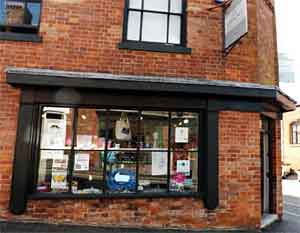
D.H. Lawrence Birthplace Museum (photograph Ruth Strong).
After lunch at the Horse and Groom, we continued to the D. H. Lawrence Birthplace Museum in Eastwood. Both Beauvale Priory and St Mary’s have links to Lawrence, being featured in disguise in his novels. St Mary’s is Greymede Church in The White Teacock and Minton Church in Sons and Tovers. Beauvale Priory is The Abbey in The White Peacock and in the short story A fragment of Broken Glass.
At the museum, we were shown a short film as an introduction and then given a guided tour of the house. The house was chosen by the Lawrences because it allowed Mrs. Lawrence to display the children’s clothes which she sold to augment the family income. It was a snapshot of life in a small house with several children in the late 19th century. It was surprising how many of the exhibits were familiar in form and usage to some members of the group. Some things change only slowly. The museum shop had a good selection of reasonably priced Lawrence novels.
Ruth Strong
* This William Savile was a 19th century mass-murderer, unrelated to the Savile family of Rufford Abbey.
SOUTHWELL WORKHOUSE
13th AUGUST 2024
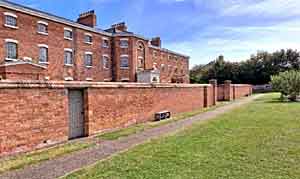
Southwell Workhouse (photograph Paul Baker).
A wonderful warm day for the excursion that started at the Workhouse. Workhouses occupy a dark place in British history and our guided tour highlighted this history. Our wonderful guide, Rosemary, explained how workhouses were part of the New Poor Law of 1834, with the intention of paupers finding shelter. Some who became destitute would not ask for help because it would mean going to the workhouse.
Workhouses catered for more than just the unemployed and our guide gave us a very full history of how many people became unemployed and were destitute at no fault of their own. No family support, elderly with no work, children without parents, people with mental illness, physical disabilities, and the sick without a carer were all offered places at the Workhouse.
Rosemary explained how the Reverend John Thomas Becher in 1828 published a pamphlet that explained how his experiment with the Southwell Workhouse had, with the help of George Nicholls who was in favour of Poor Law reform, brought the Poor Rate down by 75%. She explained how Becher had encouraged 49 parishes around Southwell to pool their resources and build a new Workhouse. Many of Becher’s ideas were used elsewhere but the Southwell example was a major influence. In 1836 the Southwell Workhouse became the Southwell Union Workhouse.
Rosemary gave us a full history of the restored Workhouse which is owned by the National Trust, and it was evident that this has allowed the history to be maintained. Throughout the tour, the architecture of the building and the people who had lived here were highlighted. As Rosemary explained, the whole restoration was carefully handled and therefore most of the original cast-iron iron fires and windows and much of the decoration has survived. The walls have been repaired and repainted but the original furniture had gone long before the restoration. Rosemary gave us a very informative tour fully appreciated by the group and before leaving for the Minster and the Bishop’s Palace we had time to have lunch in the cafe.
Arriving in Southwell in good time we were able to tour the Minster. The Minster is celebrating 140 years as a Cathedral and as part of it, a special 10-month exhibition is exploring 1,000 years of history by showcasing 14 historical objects each month.
On show for August were a Cope Chest, the Bishop of Southwell case, the Seals of Southwell, an embroidered Banner from 1884 as well as other objects. This meant the time before the visit to the Bishop’s Palace was a chance for us to be occupied exploring history from the Romans to the present day, as well as finding time to get an ice cream.
Paul Baker
THE ARCHBISHOP’S PALACE AT SOUTHWELL MINSTER
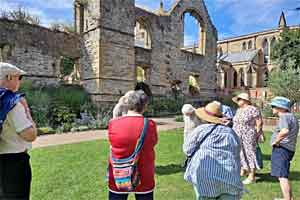 Thoroton group surveying the surviving walls of the Archbishop’s Palace (photograph Paul Baker)
Thoroton group surveying the surviving walls of the Archbishop’s Palace (photograph Paul Baker)Once again, we were very fortunate to have to a superb tour of the Archbishop’s Palace led by Victoria who met us in the Minster. We then walked over to the State Chamber along the path inscribed with decorative symbols and words written in Latin, Anglo- Saxon and modern English, which illustrated the three groups that had occupied this site. As we walked up the stairs to the State Chamber the words continued to indicate the importance of this site. Sitting in the State Chamber, Victoria explained how the Archbishops used the room to entertain Monarchs and other dignitaries and gave a history of the Palace from 956 when King Edwig gave the estate to Bishop Oskytel, who later became Archbishop of York. Victoria explained how Archbishop Aeldred, the last Anglo- Saxon Archbishop of York in the 1060s, crowned William the Conqueror in 1066 and how he lived here at Southwell. She continued to give us a full history from the 11th century to the present day. This included information on the medieval kings such as Richard I, John, Edward I, Edward II, Richard II, and Henry VI who had stayed at the Palace as guests of the Archbishops.
We were able to learn how Cardinal Wolsey spent his last months here, when he was trying to appease Henry VIII for his failure to secure his divorce from Catherine of Aragon. We also learned about King James VI of Scotland’s stay in the Palace and his admiration of the Minster as he travelled to London to be crowned James I of England upon the death of Elizabeth I. Victoria also told us that James I had hoped to buy the Palace as a hunting Lodge but the Archbishop of York refused. During the Civil War, Charles I visited several times and spent his last hours of freedom at the Saracen’s Head before surrendering to the Scots who had their headquarters in the Palace.
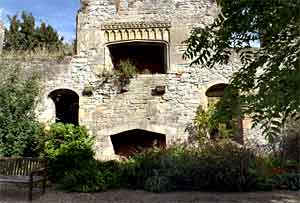 A surviving interior wall of the Archbishop’s Palace at Southwell Minster showing old fireplaces (photograph Ruth Strong).
A surviving interior wall of the Archbishop’s Palace at Southwell Minster showing old fireplaces (photograph Ruth Strong). In the present Bishop’s Garden, we were able to be shown the remains that exist and Victoria described the Palace and what it would have looked like when inhabited by the Bishops. The old ruins that exist today show remains of fireplaces and towers.
Victoria described to us as we stood in the Bishop’s garden what it is thought the Palace would have looked like with the land around, which today are the Palace Gardens. These gardens which are open to everyone were once part of the hunting grounds that would have been enjoyed by Bishops and Archbishops and their guests over many years. The Palace Gardens are well worth a visit.
Paul Baker